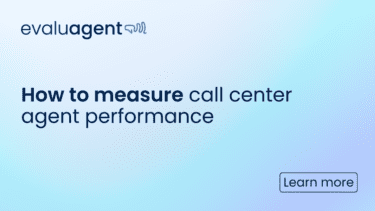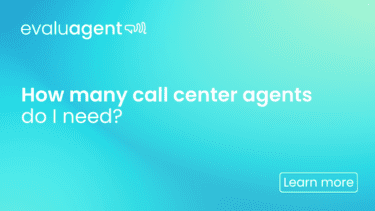In your contact centre, you can probably all agree on a few, high-level standards for a great customer interaction. Most contact centres would like their agents to sound approachable to customers, whatever channel they’re using to communicate.
But what does an approachable interaction look like when it comes down to it?
Evaluating agent interactions with customers will always contain a degree of subjectivity. A customer interaction that one evaluator scores as a “exceeds” for approachability might be scored as a “fail” by another evaluator.
And, of course, your agents and line managers might have their own opinions.
How you navigate these differences in opinions, discuss an interaction and come to a common understanding of what needs to happen for a line item to be scored a certain way to provide fair resolution to disputes is a process known as ‘contact centre calibration’. It’s an essential part of building a healthy contact centre with engaged, productive agents.
Calibrating Helps Your Evaluators Achieve a Common Understanding
In the contact centre, calibration is the most effective method in achieving a common understanding about what constitutes a successful interaction.
How does it work?
Simple. The QA team and team leaders discuss specific customer interactions to come to a consensus about what a good quality customer interaction looks like. Often an interaction is selected, blindly evaluated by each participant of the scheduled calibration session, and then discussed as a group before a “calibrated outcome” is agreed.
These calibration sessions are essential in ensuring your evaluators are aligned on key scorecard criteria, and that they can apply a consistent definition of quality across all interactions.
If you don’t calibrate, different evaluators may have different ideas about how they should score interactions. This means you risk agent feedback being patchy, unreliable and difficult to derive genuine insight from.
How To Run Effective Calibration Sessions
For all its benefits, it’s easy to run calibration sessions badly. For example, changing how you’ve initially scored a line item in order to “fit in” with the rest of the group can be more common than you’d like to think.
As a result, calibration often ends up as a top-down process in which senior management imposes their own standards, opinions and perceptions on the rest of the team to follow.
If you make your calibration sessions inclusive, collaborative and open, however, they’re much more likely to generate meaningful conversations, fair resolutions and clearer understanding of what constitutes a great customer interaction across the entire business.
The key that unlocks these benefits? Collaboration.
The most effective calibration sessions are collaborative.
For your calibration sessions to be useful, they need input from everyone involved in your contact centre – including and especially the agents themselves.
Considering diverse perspectives from agents, your QA team, line managers, service team leads and senior management ensures:
- An objective, organisation-wide understanding of what a quality customer interaction looks like.
- Everyone feels part of the process, so that calibration isn’t seen as an out-of-touch, top-down imposition.
- More generally, increased levels of employee engagement as frontline teams can own their performance.
The most effective calibration sessions are balanced.
It’s easy for calibration sessions to skew towards evaluation of negative customer interactions. This is frustrating for agents, who feel that they’re constantly made aware of their failures but never celebrated for their successes.
It’s also unhelpful for you as a business. If you know exactly what constitutes failure but never discuss what success looks like, how do you expect your agents to excel?
To address this balance, you could encourage your agents to select some calls for calibration themselves or make sure the session host has a clear direction of which interactions should be calibrated. This is a great opportunity for agents to show you how they go above and beyond for customers, or to ask for feedback on difficult interactions on their own terms.
As a result, your calibration sessions become an opportunity for overall growth, rather than a vehicle for negative thought.
Need more QA insight and advice? Download our Essential Guide to Call Centre Quality Monitoring now!




